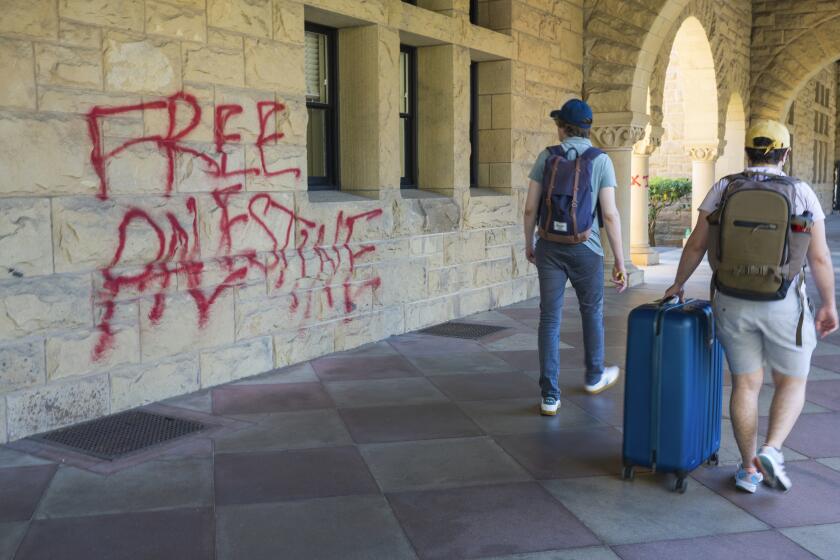Making Special Ed Live Up to the Name
- Share via
Under a watchful adult’s eye, the 3-year-old in the striped shirt clutched an overhead trapeze bar and skidded his feet down a ramp slick with shaving cream. Timmy Addison laughed at the slippery mess he was making: This is great fun.
It’s also serious business.
What may look like silly play was actually occupational therapy that helps this Laguna Niguel preschooler cope with his tuberous sclerosis, a genetic disorder characterized by tumors on the brain and body. In Timmy’s case, the benign growths hinder his speech, his ability to manipulate his fingers and his upper-body strength--thus the trapeze exercise.
For the first time, the Capistrano Unified School District is providing therapeutic services on-site to students such as Timmy. The district’s first occupational therapy center opened earlier this year at Crown Valley Elementary in Laguna Niguel and was formally dedicated earlier this month.
The move recognizes the new realities of special education: In the last decade, the number of California schoolchildren with physical, emotional and learning disabilities has grown 35%, while funding for special education lags. This leaves local school districts to make up the difference, often cutting deep into general fund budgets.
Capistrano Unified is no exception. Like school districts across the country, it has witnessed an explosion in requests for special-education services--and parent victories compelling school districts to provide specialized care. If school districts are ill-equipped to do so, they must foot the bill for privatized care.
The number of Capistrano students like Timmy requiring occupational therapy--in which trained specialists help students build enough spinal strength to sit upright at a desk or teach kids how to hold pens, for example--jumped from 125 to 201 in the last two full school years. Likewise, costs have soared from $353,340 to $558,293 to pay for care at and transportation to outside clinics.
With the new center, district officials believe they can eventually save $50,000 a year after initial start-up costs and better help kids prepare for classroom work. They call it the do-it-yourself model.
*
“In the past, we have contracted with outside people at a fairly expensive rate,” Supt. James A. Fleming said. “One of the benefits of having a district of our size, you reach a point when it makes better sense to hire your own person and you can proceed with your own program.”
It’s also a trend that is likely to expand, according to Paul Goldfinger, a financial consultant with School Services of California, a private lobbying and consulting group. Recent changes in state law make it easier for school districts to put therapists on their payroll and change funding methods for special education, effectively discouraging the reliance on outside contractors.
“I think this is great for kids,” Goldfinger said. “Often kids are served better in school than when they’re sent off-campus. As long as districts can hire enough qualified people, I don’t see any downside.”
A special-education advocate cautiously agrees.
Having therapy at schools can eliminate burdensome transportation problems for parents and help teachers and therapists work closer together to help children, said Marta Anchondo, deputy director of the Team of Advocates for Special Kids, an Anaheim-based parent organization for special-education students of all ages and disabilities.
*
“If the school district can provide the same quality and quantity of services as [private contractors], it can be a benefit for families,” she said. “The key issues are quality and quantity.”
Initially, Capistrano’s program is starting small.
Housed in two rooms at Crown Valley, occupational therapist Claudia Ginsberg-Brown works with about 15 kids one-on-one and also conducts group therapy for several autistic students. Depending on a child’s individual needs, she might help them grasp “pinch-pins,” clamps that help them develop gripping skills necessary to use scissors. Those whose schoolwork is hampered by difficulty holding pencils might wield a purple vibrating pen to help develop hand control. Others will work on balance and courage by climbing mattress-like “squishy pillows.”
By year’s end, the district hopes to add another therapist or two and expand services.
Timothy’s mother, Lee Ann Addison, is a devoted fan of the new center. At the school, she gets to help with therapy sessions, which isn’t always allowed in private settings for liability reasons.
“If we went to an outside source, I wouldn’t be able to be here with him,” said Addison, who says her son is six to 12 months behind others his age, but improving all the time. “I hope by kindergarten, we can have him ready for a regular classroom.”
More to Read
Sign up for Essential California
The most important California stories and recommendations in your inbox every morning.
You may occasionally receive promotional content from the Los Angeles Times.










